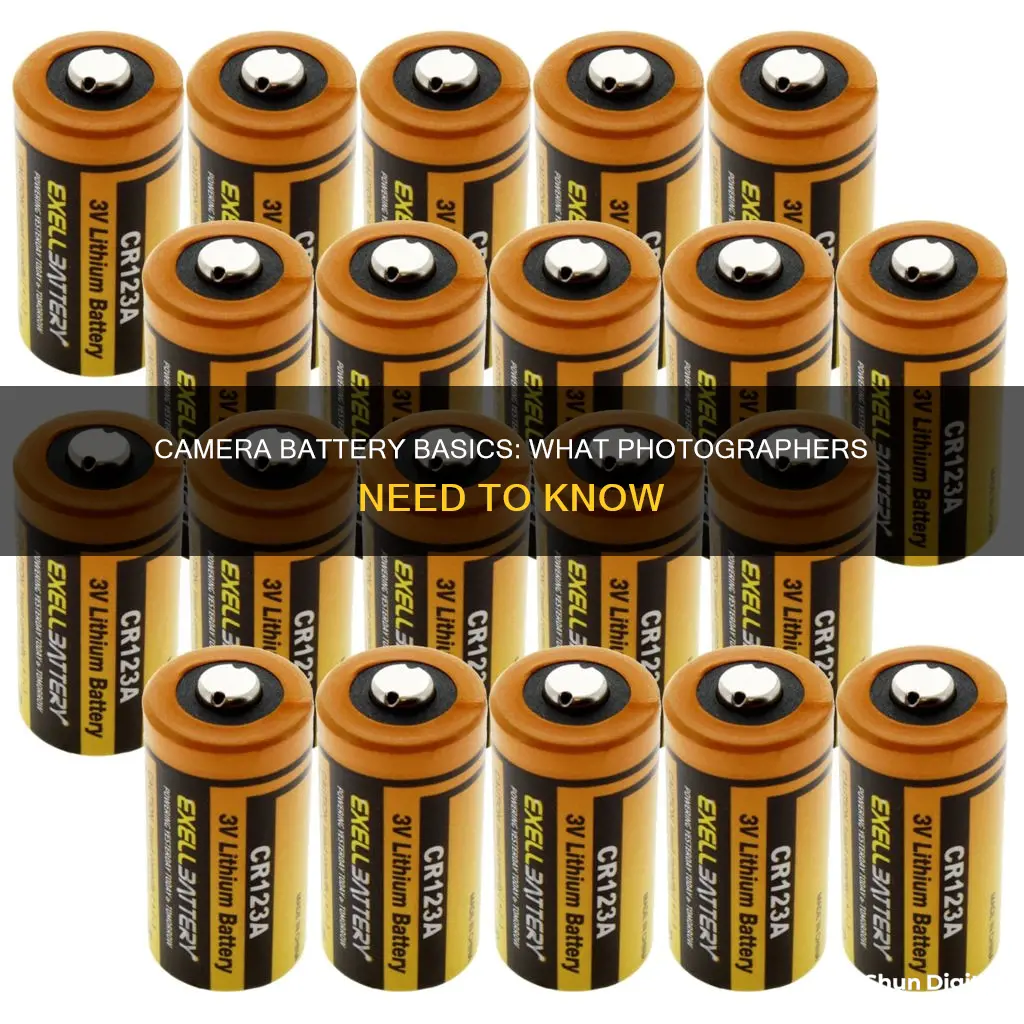
Camera batteries are an essential component of photography, and understanding how to maximise their lifespan and effectiveness is key to capturing those precious moments. While older digital cameras relied on disposable AA batteries, most modern cameras feature rechargeable lithium-ion batteries, which offer higher charge capacity and longer lifespans. This guide will explore the different types of camera batteries, best practices for prolonging their life, and factors to consider when choosing a battery system.
| Characteristics | Values |
|---|---|
| Battery type | Rechargeable lithium-ion, AA, AAA |
| Battery life | Influenced by usage, storage, and number of recharges |
| Charging | Avoid overcharging or fully draining; store at room temperature |
| Power-saving | Use viewfinder instead of LCD screen; turn off camera when not in use |
| Battery health | Check for corrosion, scratches, or smudges on metal contacts |
| Replacement | Replace old or damaged batteries; consider carrying spare batteries |
| Battery grip | Doubles shooting capacity by accommodating two batteries |
| USB charging | Widely compatible but slower and with limited power output |
What You'll Learn
- Rechargeable batteries last longer and are more eco-friendly than disposable batteries
- Lithium-ion batteries are now standard, but nickel-metal hydride batteries are another option
- Avoid extreme temperatures when storing and using batteries
- Battery grips can double the shooting capacity of your camera
- USB charging is convenient but slower than a dedicated charger

Rechargeable batteries last longer and are more eco-friendly than disposable batteries
Rechargeable batteries are a more sustainable and cost-effective option than disposable batteries. While disposable batteries tend to have a longer initial charge, rechargeable batteries are more convenient and cost-efficient in the long run.
Rechargeable batteries can be charged hundreds of times, offering thousands of hours of use. This makes them significantly more cost-effective than disposable batteries, which cannot be recharged and need to be replaced frequently. Rechargeable batteries are also more environmentally friendly, as they produce less waste. Even with the cost of a charger included, rechargeable batteries will pay for themselves in five to six recharge cycles, compared to buying most brand-name disposable batteries.
Rechargeable batteries are ideal for high-drain devices, such as digital cameras, that quickly drain a lot of energy. Lithium-ion rechargeable batteries, for example, have a larger power capacity and can be easily recharged, saving you from the hassle of constantly purchasing new batteries. They are also commonly used to power portable consumer electronics, providing more value for money.
Nickel-metal hydride (NiMH) rechargeable batteries, in particular, are a popular choice for photographers. With their high charge capacity, they are designed for high-drain devices and can deliver maximum performance in a wide range of temperatures. NiMH batteries can also retain up to 80% of their total power when left idle for 12 months, making them a reliable option for capturing fleeting moments without worrying about flat batteries.
In addition to their longevity and cost-effectiveness, rechargeable batteries are also safer for your devices. They are less likely to leak than disposable batteries, reducing the risk of nasty corrosion in your gadgets. By choosing rechargeable batteries, you can avoid the hassle of constant replacements and contribute to a greener planet.
Charging Nixon Camera Batteries: A Step-by-Step Guide
You may want to see also

Lithium-ion batteries are now standard, but nickel-metal hydride batteries are another option
Lithium-ion (Li-ion) and nickel-metal hydride (NiMH) batteries are the two main types of rechargeable batteries used in digital cameras. While Li-ion batteries are now standard, NiMH batteries are another option. Here's what you need to know about these two types of batteries:
Lithium-ion batteries have become the standard choice for digital cameras, including DSLRs and mirrorless cameras. They offer several advantages over other types of batteries. Firstly, they have a higher power capacity, providing a lot of use for your investment. Secondly, they are smaller in size, making them ideal for portable devices. Additionally, Li-ion batteries recharge faster and have a longer lifespan. Many camera manufacturers stick with a specific lithium-ion battery design across multiple generations of cameras, allowing users to continue using the same batteries when upgrading their camera equipment. However, one drawback of Li-ion batteries is their potential safety hazards during production, use, and transportation due to the active chemical properties of the lithium element.
On the other hand, NiMH batteries, commonly found in rechargeable AA and AAA batteries, offer their own set of advantages. NiMH batteries have a high energy density, allowing them to store two to three times more energy in the same space as traditional batteries. They are also more cost-effective than Li-ion batteries, as they are less expensive to produce and have been around since the early 1970s. NiMH batteries are known for their environmental friendliness, good cycle life performance, and safety record. Additionally, they do not require a complex battery management system (BMS), although adding one can improve the battery's longevity and communication with the device.
When choosing between Li-ion and NiMH batteries for your camera, consider factors such as power needs, cost, and durability. While Li-ion batteries are the current standard, NiMH batteries offer a cost-effective alternative with their own unique benefits.
Charging Your Panasonic Lumix DMC-FZ70 Camera Battery: A Guide
You may want to see also

Avoid extreme temperatures when storing and using batteries
Extreme temperatures can be very damaging to camera batteries. When exposed to very high or very low temperatures, rechargeable batteries can be permanently damaged. Therefore, it is important to always store your batteries at room temperature.
It is also important to never put a hot or warm set of cells into a charger. Allow them to cool down to room temperature first. Similarly, do not charge your cells in a hot environment, such as in a closed car in the sun.
When shooting in cold conditions, keep your spare batteries warm by storing them inside your coat, close to your body. This will help them maintain their full charge for longer.
Additionally, high temperatures can accelerate chemical reactions in batteries, and in rare cases, this can cause batteries to explode. This is very unusual with camera batteries but has occurred with larger laptop batteries.
Low temperatures can slow down the chemical reactions in batteries, which may affect camera performance. Although most batteries can handle sub-zero conditions, it is still recommended to keep spare batteries warm when shooting in cold environments.
Are Camera Batteries Charged? Understanding Camera Battery Basics
You may want to see also

Battery grips can double the shooting capacity of your camera
Battery grips are a handy accessory for digital cameras that can hold one or two of the camera's regular batteries. They attach underneath a DSLR, increasing the overall size of the camera body and giving it a larger square shape.
The main advantage of using a battery grip is that it allows the use of two batteries at once, effectively doubling the camera's battery life. This can be a huge advantage when shooting all day or recording a longer time-lapse video.
In addition to increased battery capacity, battery grips also offer improved ergonomics and comfort when holding the camera, especially for those with larger hands or those using heavier lenses. The grip extends the surface where your right hand rests, allowing more room for your fingers to spread and providing a larger area for your palm to rest.
Another benefit of battery grips is the dedicated controls for shooting in portrait mode, including the shutter release, main index dial, AF selection button, AF-ON button, AE Lock button, and thumb AF selection button. These controls allow for a more comfortable and natural shooting position when taking vertical photos.
While battery grips offer significant advantages, there are also some disadvantages to consider. They can be costly, with OEM models priced higher than third-party options. Additionally, the increased size and weight of the grip may be uncomfortable for some photographers, especially during extended periods of handheld shooting.
Overall, battery grips can be a valuable investment for photographers looking to extend their shooting capacity, improve ergonomics, and gain additional controls for portrait shooting.
Charging Camera Batteries: Do They Need a Full First Charge?
You may want to see also

USB charging is convenient but slower than a dedicated charger
USB charging is a convenient way to charge your camera battery, especially when you are on the go and don't want to carry a second battery charger. It is also budget-friendly since it eliminates the need for a separate charger. Additionally, it is easy to use as it does not require a dedicated charger and enables mobile charging. Furthermore, it is a widely universal method as most gadgets with a USB port can be charged via USB.
However, one of the main drawbacks of USB charging is its slow speed. If you need to charge your camera battery quickly, USB charging may not be the best option as it is slower than using a dedicated charger. This is because USB charging only produces a small amount of power, which might not be sufficient to fully charge larger batteries. For instance, some USB ports may not supply enough power or may take a long time to charge a camera battery. In such cases, using a specialised battery charger may be more effective.
Additionally, not all camera batteries are compatible with USB charging. Older camera models may not support this charging method, and some batteries may require a specific type of USB camera battery charger. Therefore, it is crucial to consult the manufacturer's instructions before attempting to use USB charging. The power output of the USB port is also a crucial factor to consider.
Browning Trail Cameras: Maximizing Battery Life
You may want to see also
Frequently asked questions
Most digital cameras use rechargeable lithium-ion batteries. Some cameras also use AA or AAA batteries, which can be alkaline, lithium, or nickel-metal hydride (NiMH).
A camera battery should last at least five years if it's handled correctly and isn't faulty. After a few hundred cycles, a battery's capacity may fall below half, and it should be replaced.
To prolong your camera battery's life, avoid extreme temperatures, don't fully discharge the battery, store it at room temperature, and recharge it regularly. Additionally, try to avoid using battery-intensive camera features, such as the LCD screen.
Some newer camera models support USB charging, but not all. Check your camera's handbook or specifications to see if it supports USB charging and what type of cable or adapter is needed.







